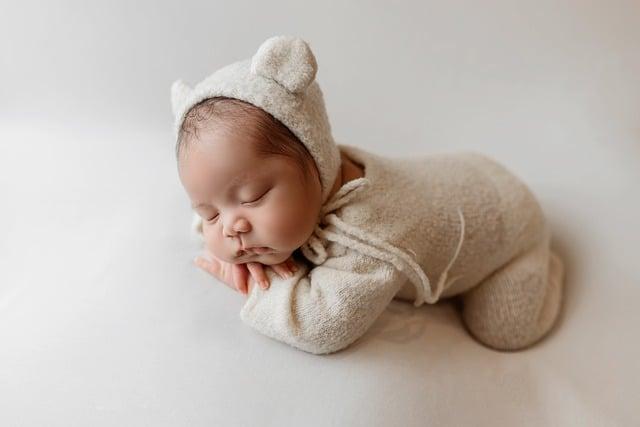As the world quiets down and night envelops your home, the comfort of your sleeping baby becomes the utmost priority. Yet, unbeknownst to many parents, infants are particularly vulnerable to fluctuations in temperature. Unlike adults, babies cannot regulate their body heat effectively, making it essential for caregivers to be vigilant about their little one’s warmth during the night. Knowing how to discern whether your baby is too cold can lead to a more restful sleep for you both. In this article, we will explore the key signs that indicate your baby may be chilly, as well as practical tips to ensure they stay snug and cozy throughout the night. Understanding these signals empowers you to create a safe and comfortable sleep environment, allowing your baby to drift off peacefully, no matter the season.
Understanding Baby Temperature Regulation
Understanding how your baby regulates temperature is essential for ensuring their comfort throughout the night. Unlike adults, babies have a limited ability to adjust their own body heat, making them particularly vulnerable to temperature fluctuations. Their small size and low fat reserves mean they can lose body heat rapidly, especially when exposed to chilly environments. It’s crucial for caregivers to monitor surrounding conditions and make adjustments accordingly, keeping in mind that what feels comfortable for adults may not be adequately warm for a developing infant. Optimal sleeping conditions can be achieved by ensuring the nursery maintains a stable temperature that’s neither too hot nor too cold.
When assessing whether your baby is too cold at night, look for specific cues that signal discomfort. Some common signs include a cool chest or neck, and visible discomfort that may manifest as fussiness or unusual movements. Additionally, shivering is a clear indication that your baby is feeling cold. To maintain warmth, consider dressing your baby in layers, using sleep sacks, and ensuring that the crib is adequately insulated from drafts. Regular checks during the night can help you gauge your baby’s temperature, creating a safer and more comfortable sleeping environment.
Signs Your Baby May Be Cold at Night
As parents, it’s crucial to recognise when your baby might be feeling chilly during the night. One of the most telling signs is the temperature of their extremities. If your baby’s hands and feet feel cold to the touch, even if their core temperature seems fine, it might indicate they are not adequately warm. Additionally, observe their sleeping behavior; if they frequently stir, fuss, or seem restless, this could be a sign that they are uncomfortable due to cool surroundings.
Another important aspect to monitor is your baby’s overall body language and sleep position. If you notice your baby curling up tightly or clenching their fists, they may be seeking warmth. Keep an eye out for any shivering or a slight change in skin color, such as a pallor or bluish tint, particularly around the lips. These signs can suggest that your little one needs extra layers or a cozy sleep environment to ensure a restful night.
The Importance of a Comfortable Sleep Environment
A comfortable sleep environment is crucial for your baby’s wellbeing. The right room temperature can greatly affect how well your infant sleeps, helping to prevent restlessness and ensuring they stay cozy throughout the night. Aim for a room temperature between 68°F and 72°F (20°C to 22°C), which is generally recognized as ideal for infants. If the room is too cold, babies may exhibit signs that should not be ignored. Ensuring your little one is dressed in appropriate sleepwear and bedding can make a significant difference, as they should be dressed in one additional layer than what feels comfortable for you while sleeping.
Being attentive to your baby’s cues is essential for maintaining their comfort. Some signs that indicate your baby might be feeling too chilly include cool skin on their chest or neck, restlessness during sleep, and a pale complexion. Touching your baby’s back or chest can help you gauge their temperature effectively. If you notice any of these signs, consider adjusting their sleep environment promptly by either adding layers or modifying the room temperature. By fostering a warm, nurturing atmosphere, you can help your baby enjoy deeper, more restorative sleep.
Monitoring Room Temperature for Optimal Comfort
Maintaining an optimal room temperature is crucial for your baby’s comfort and safety during sleep. The ideal environment typically falls within the range of 20° to 22°C (68° to 72°F), ensuring that your little one remains cozy throughout the night. To monitor the temperature effectively, consider using a reliable room thermometer, which allows you to make necessary adjustments. Additionally, dressing your baby in breathable fabrics can help regulate their body heat. When evaluating the room conditions, pay attention to the following signs that your baby may be too cold:
- Cold extremities: Feel your baby’s hands and feet to see if they are noticeably cooler than the rest of their body.
- Excessive fussiness: If your baby seems unusually restless or irritable, it may indicate discomfort due to the room temperature.
- Shivering or changes in skin color: Look for signs of shivering or a bluish tint to their skin, which could suggest they are cold.
To further ensure your child’s comfort, adjust bedding and clothing as necessary based on the room’s temperature. Use lightweight, breathable blankets and pajamas to avoid overheating while also providing warmth. Remember, each baby is unique, and their comfort may vary from one night to the next, so regular checks throughout the night can be beneficial. Keep an eye on these subtle cues and make timely adjustments to create the most comfortable sleep environment for your baby.
Choosing the Right Sleepwear for Your Baby
When selecting sleepwear for your baby, it’s essential to consider both comfort and safety. The ideal sleepwear should be made of soft, breathable materials that help regulate body temperature. Look for options such as:
- Cotton or bamboo fabrics that wick away moisture
- Sleep sacks that provide warmth without the risk of loose blankets
- Layered outfits, allowing for easy adjustments depending on room temperature
Additionally, ensure that the fit is snug but not too tight to allow for safe movement. Pay attention to your baby’s cues; if they feel too warm or cold, adjust their sleepwear accordingly. Consider the room temperature and dress your baby in layers to provide the flexibility needed to keep them cozy throughout the night:
- Long-sleeve onesies under sleep sacks for cooler nights
- Short-sleeve pajamas or lightweight blankets for warmer evenings
- Footed sleepers to keep tiny toes warm
How to Use Blankets Safely for Extra Warmth
When considering adding blankets for extra warmth, it’s crucial to adhere to safety guidelines to prevent the risk of suffocation. While many parents instinctively want to ensure their baby is warm during chilly nights, introducing blankets too early can be harmful. It’s recommended to wait until your baby is at least 12 months old before using blankets. Until then, instead of blankets, dressing your baby in layered sleep clothing can effectively keep them warm without the dangers posed by loose bedding.
Once your baby reaches the appropriate age, you can safely introduce a lightweight blanket. When using a blanket, make sure it is not too thick and is sized properly for the crib, ideally reaching just the foot of the mattress. Here are some tips to enhance safety while ensuring your baby stays warm:
- Use breathable materials, such as cotton or muslin, to prevent overheating.
- Ensure the blanket is tucked in securely to reduce the chance of your baby pulling it over their face.
- Always position your baby to sleep on their back, which is the safest sleep position.
The Role of Maintaining a Consistent Temperature
Maintaining a consistent temperature in your baby’s sleep environment is crucial for their comfort and overall health. Babies are particularly sensitive to temperature fluctuations, and being too cold at night can lead to disrupted sleep patterns and distress. To ensure your little one remains in a comfortable range, consider the following effective strategies:
- Dress them appropriately: Use layers that can be added or removed as needed to regulate warmth.
- Optimal room temperature: Aim for a sleeping environment between 68°F and 72°F (20°C to 22°C).
- Check for drafts: Ensure windows and doors are sealed to prevent chills.
Understanding your baby’s unique signals is essential in gauging their comfort level throughout the night. While a cozy environment is vital, keep an eye out for signs that may indicate your baby is cold, such as:
- Cold extremities: Hands and feet feeling noticeably cooler than the body.
- Shivering or fussiness: An abrupt change in behavior can be a key indicator.
- Difficulty settling down: If they’ve been unusually restless, check their temperature and comfort.
Recognizing Subtle Behavioral Cues in Your Baby
Understanding your baby’s subtle behavioral cues can be essential in determining whether they are feeling cold at night. Babies often communicate their discomfort through body language and facial expressions. Pay attention to these signs that might indicate your little one is chilly:
- Shivering or trembling: This is a common response to cold, even in infants.
- Clenching fists: A signal they may be feeling uncomfortable.
- Restlessness: If your baby is unusually fidgety, it may be a sign that they are not warm enough.
Additionally, observing your baby’s skin can provide vital clues. If their skin feels noticeably cold to the touch or appears pale, it’s important to act. Other signs include:
- Increased lethargy: If your normally active baby seems drowsy or less responsive, it could indicate they are struggling with the temperature.
- Changing their expression: A grimace or frown might suggest discomfort, which can relate to feeling cold.
- Seeking warmth: Babies may snuggle closer to you or pull at their blankets if they are cold.
Practical Tips for Keeping Your Baby Warm
Ensuring your little one stays warm at night is essential for a peaceful sleep. Start by checking the room temperature; ideally, it should be between 68°F and 72°F (20°C to 22°C). Use a thermometer to keep track, and if you find it colder, adjust the heating if necessary. Dress your baby in breathable layers to allow for some flexibility in temperature regulation. It’s wise to opt for sleep sacks instead of blankets, as they minimize the risk of suffocation and provide a consistent warmth that traditional bedding may not.
To further gauge your baby’s comfort, pay attention to physical cues that may indicate they are too cold. Check their hands, feet, and neck; if they feel cool to the touch but their torso is warm, they might be just fine. If they seem to be unusually fussy or restless, or if they wake frequently, it could be a sign they are not warm enough. Always remember to adjust their clothing as necessary, adding a soft hat or socks if you notice chilliness, and avoid overdressing, which can lead to overheating. Regular checks will help ensure they enjoy a sound night’s sleep.
When to Seek Help: Identifying Signs of Hypothermia
Recognizing the signs of hypothermia in your baby is crucial, especially as temperatures drop at night. Monitor your child for increased irritability, extreme lethargy, or unresponsiveness. Pay attention to their skin; if it appears pale, cold to the touch, or has a bluish tint, these can be early indicators of trouble. Other symptoms include shivering, which may cease as the condition worsens, and changes in heart rate or breathing patterns. Being vigilant means you can act swiftly when you notice symptoms that may suggest your baby is too cold.
If you suspect that your baby is becoming hypothermic, it’s important to seek help immediately. Any sign of significant discomfort, pronounced shivering, or confusion is a signal that professional assistance may be necessary. Keep in mind that babies do not communicate their needs the same way older children or adults do, making it especially important to trust your instincts. Warming your baby gradually with blankets, skin-to-skin contact, and reducing exposure to cold environments are essential; however, don’t hesitate to contact a healthcare provider to ensure their safety and well-being.
Creating a Cozy Nighttime Routine for Your Baby
Establishing a cozy nighttime routine for your baby is essential for ensuring they feel safe and secure as they drift off to sleep. Start by creating a soothing environment in your baby’s nursery where calmness prevails. Consider incorporating the following elements:
- A Dimly Lit Room: Use soft lighting to create a peaceful ambiance.
- Comfortable Temperature: Ensure the room temperature is optimal, ideally between 68-72°F (20-22°C).
- Soft Textiles: Use gentle, breathable fabrics for bedding and sleepwear.
- Consistent Sounds: Introduce a white noise machine or gentle lullabies that can help mask other noises.
As you move through your routine, pay attention to your baby’s cues to ensure they are comfortable. Close observation can help you identify if your baby is feeling chilly. Signs to look for include:
- Cold Extremities: Touch your baby’s hands and feet; they should feel warm to the touch.
- Fussiness: Increased discomfort or fussing can indicate that they are not warm enough.
- Cuddling or Huddling: Look for signs of your baby curling up more than usual, which can suggest they are seeking warmth.
- Pale Skin: If your baby’s skin appears unusually pale, they may not be adequately warm.
To Conclude
As the night wraps its quiet embrace around your home, ensuring your little one is comfortable becomes paramount. Observing your baby’s cues, from the subtle shivers to the warmth of their skin, can guide you in creating a snug sanctuary where restful slumber reigns. Remember, a blanket of warmth is essential, but so is the freedom for your baby to move and breathe freely. With attentive care and a watchful eye, you can transform those chilly nights into cozy experiences that foster sweet dreams and peaceful nights, leaving both you and your baby refreshed for the day ahead.




